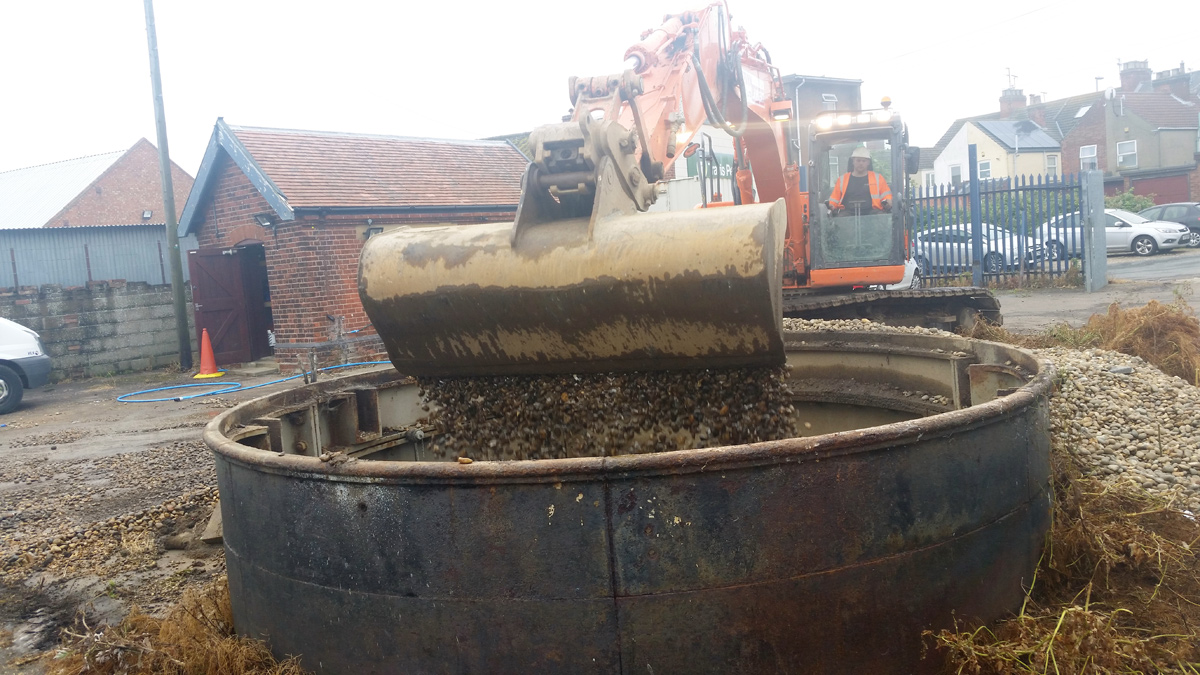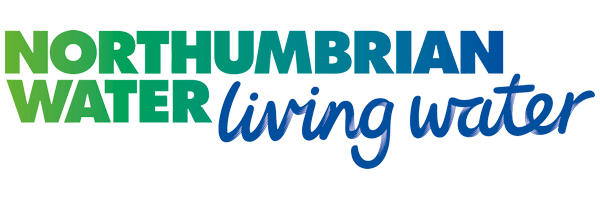River Yare Pipeline Crossing & Tunnel Decommissioning (2019)

Inside Yare Tunnel and its two strategic water mains - Courtesy of Northumbrian Water Limited
As part of a continued effort to improve service to customers and ensure resilience and security of supply, the team at Northumbrian Water Limited together with Stantec UK carried out an investigative study of the issues related to the River Yare Strategic Crossing and identified a cost effective solution that achieved these objectives. The Great Yarmouth Tunnel was constructed in the early 20th century to enable water from the Ormesby Water Treatment Works (WTW) to supply Great Yarmouth and Gorleston on Sea, Cobham and Southtown. This zone also includes the James Paget University (Accident and Emergency) Hospital. The water is supplied solely by Ormesby WTW at 19.2 Ml/day. This water is pumped to Caister Tower and from here it supplies all of the Great Yarmouth area at 15.5 Ml/day. The structure is 108 years old and is constructed of small metal plates bolted together to form the cylindrical shape of the structure. The tunnel is strategic to the distribution network as it houses an 18 inch and a 21 inch water main, which has approximately six hours support from the Gorleston Reservoir. Should these mains fail for any reason, the result would be a loss of supply to approximately 19,000 properties once emptied.
Overview
The tunnel is classified as NC4 confined space which is the highest risk since the presence of methane gas was found and requires a specialist team to manage and facilitate safe entry. This can be difficult, time consuming and expensive. As such the tunnel and pipework have received little to no maintenance over the last 30 years and is currently in a state of disrepair and the mains have deteriorated.
If the water mains fail, a repair could not be carried out quickly. This crossing is the only means of getting a potable water supply to the south of Great Yarmouth and loss of supply would mean a population of 47,500 people would be without water in a matter of hours. In the event of a major failure, the tunnel would be out of service for several weeks and the cost to the business of such a failure would be very high. The company would be required to cover not only the cost of the repairs but also provision of an emergency supply of water.
The NWL Customer Charter requires automatic refunds be made to domestic customers affected by loss of supply for more than 24 hours. A loss of the Yare Tunnel Crossing would equate to £380,000 in refunds on the first day and £190,000 every day without supply of water thereafter.

The welded polyethylene pipe is laid out in one continuous length prior to being pulled through – Courtesy of Northumbrian Water Limited
Business justification for the project
The Assessment of Low Failure Asset (ALFA) study undertaken as part of the PR14 submission identifies this crossing as the highest overall risk in the Suffolk area. The chance of partial to complete failure due to some degree of corrosion, deterioration or damage from third party makes this a high risk structure in terms of likelihood.
Some remedial work was carried out in 2010, but since then there has been further deterioration. The most recent inspections of the tunnel and pipework was carried out in 2014 and the report highlighted the following:
- Significant cracks in the concrete head walls.
- The eastern shaft was not truly plum.
- The water mains were deteriorating and the couplings were badly corroded.
- Shaft covers needed replacing and brought up to the latest industry requirements for this structure as a strategic crossing.
- Redundant equipment in the tunnel to be removed, e.g. oil sump pump, electrical equipment, cabling, sundry pipework.
- Ventilation system in disrepair and to be replaced with forced and controlled intrinsically safe ventilation system.
- Installation of new sump pump required.
- Improve drainage at floor level.
- Repair tunnel plates with caulking and new bolted segments.
Salt water ingress from the river was ongoing. The existing submersible pump was not in working order and the measure of water level in 2014 was 450mm at the lower end of the tunnel. Previous attempts to resin grout holes in the tunnel lining were unsuccessful. There was no lighting in the tunnel, the strip lighting did not work and was never intrinsically safe and classified as battery lighting.

Aerial view of the pipeline drilling operation – Courtesy of Northumbrian Water Limited
Optioneering
A number of conceivable options were explored during the project feasibility to resolve the problems and address the risks associated with the Yare Crossing as follows:
Retain and refurbish the existing tunnel and water mains: This option presented constraints such as high risk confined space working environment for an extended period, limited working room making it difficult to undertake much of the work required. CAPEX costs for this option estimated at £3.04m with an estimated ongoing OPEX cost of £22,500 per year.
Micro tunnel: This option involves the construction of a new small diameter micro tunnel with no man entry access. The option proposes the installation of our new 355mm polyethylene pipelines through 400mm PVC sleeves through 1200mm diameter tunnel with the abandonment of the existing tunnel. A number of issues have been foreseen with this option, the first is it presents a number of engineering challenges, land purchase would be required. The estimated CAPEX cost for this option stood at £5.11m with an OPEX cost of £6,000 pa.

The polyethylene pipe is butt welded and the external bead removed. Butt welded joints are virtually the same strength as the pipe – Courtesy of Northumbrian Water Limited
Horizontal directional drilling (HDD): To directionally drill two new 500mm (OD) polyethylene pipes beneath the River Yare, abandon the existing strategic mains and decommission the tunnel structure. The HDD process is simple and presents less engineering difficulties than the micro tunnelling.
There are no land purchase issues to consider, however access during the construction phase needed to be negotiated. The project teams estimate for this option £1.07m. With decommissioning of the tunnel, abandonment of the existing mains the OPEX cost for this option is zero.
Preferred option/the project
The proposed scheme was for the complete replacement of the Yare Tunnel Crossing which houses the two strategic water mains. The engineering solution chosen for the replacement of the tunnel was the horizontal directionally drilling (HDD) two new 500mm (OD) PE water main beneath the River Yare. The new mains were located 100m north of the existing tunnel and geotechnical surveys confirmed the ground conditions either side of the river suitable for HDD. This was critical as controlling the directional drill requires ground conditions not to be too soft.
The HDD method is quite simple and involves a machine that has the capacity to push and pull and rotate a drill rod. Once the HDD machine has pushed a full stroke, the rotational gear box is disconnected, another section of the drill rod is inserted, the machine pushes again and this process is continued until the drill head reaches its destination point.
A major part of the cost associated with the HDD method is mobilisation and demobilisation of the required specialist equipment, but the cost of each pipe installation can be significant as this technique tends to favour smaller number of smaller pipes. Hence the use of HDD for two 500mm (OD) pipes was a preferable match.
This technique required a launch pit from where the drilling machine operates and a long space on the opposite side of the river beyond the reception pit, enough for the pipe to be laid out as a continuous welded length before being pulled back. This presented the team with a challenge as the area in and around the river did not lend itself well to this arrangement as the space available was constrained by the presence of the A12 road and embankments. There were four mains connections carried out, two on the west side (Cobham Island) and two on the east side just outside Quay Mill Walk (North Quay).
The HDD drilling was carried by framework contractors Integrated Water Services Limited, the pipeline design and hydraulics was carried out by a combination of NWL in-house Design and Networks teams while the pipework connections and disconnections was by NWL in house DMO teams.
River Yare Pipeline Crossing & Tunnel Decommissioning : Supply chain
- Principal contractor (HDD): Integrated Water Services
- Project designers/pipeline installation/connections, tunnel decommissioning: NWL in house teams
- Pipe Suppliers: Aliaxis UK
- Feasibility study: Stantec UK Limited
Decommissioning of the Yare Tunnel and pipework
The installation of the two new 500mm pipes beneath the River Yare also meant the abandonment of the Yare Tunnel Crossing and for the tunnel to be made safe. It was considered that the best way to do this was to block off the tunnel mouths and fill the shafts up to ground level with foam concrete. It was considered that there is no benefit in filling the tunnel since the eventual collapse would cause no detrimental effects on the river – the tunnel would just fill with mud.

Northumbrian Water in house delivery team decommissioning the tunnel and redundant strategic water mains – Courtesy of Northumbrian Water Limited
The shaft covers were removed and the shafts filled initially with coarse gravel and hardcore and then filled in at the top with foam concrete. The top rings of the shafts were removed down to approximately 1m below ground level and cement used to capped off and backfilled over. The two mains were physically disconnected to ensure no deadlegs present a contamination risk to the rest of the network. This package of work was carried out by NWL in-house delivery teams.

Filling in tunnel shafts with hard core and gravel – Courtesy of Northumbrian Water Limited
NWL in house design and pipeline installation teams worked collaboratively with IWS and its drilling subcontractor to ensure that the installation of the pipes and decommissioning of the tunnel was carried out safely and with minimum disruption to the surrounding community.
The scheme was completed on time and within budget and with the in-house delivery approach, realised significant cost savings for Northumbrian Water.




